tow Citroen DS4 RHD 2013.5 1.G Owner's Guide
[x] Cancel search | Manufacturer: CITROEN, Model Year: 2013.5, Model line: DS4 RHD, Model: Citroen DS4 RHD 2013.5 1.GPages: 400, PDF Size: 31.86 MB
Page 197 of 400
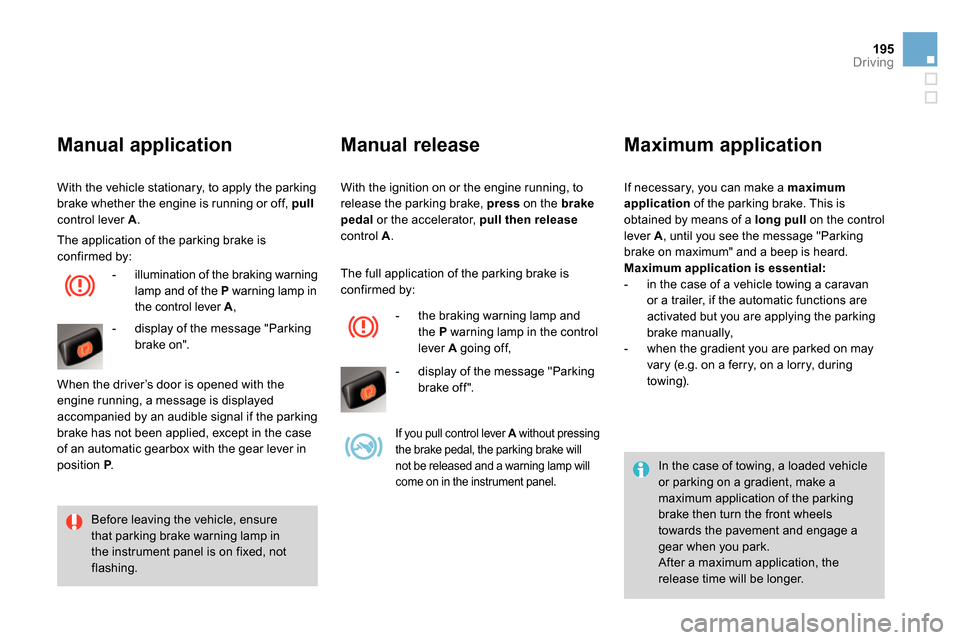
195Driving
With the ignition on or the engine running, to
release the parking brake, press
on the brake
pedal
or the accelerator, pull then release
control A
.
Manual release
Before leaving the vehicle, ensure
that parking brake warning lamp in
the instrument panel is on fixed, not
flashing.
Manual application
With the vehicle stationary, to apply the parking
brake whether the engine is running or off, pull
control lever A
.
The application of the parking brake is
confirmed by:
- illumination of the braking warning
lamp and of the P
warning lamp in
the control lever A
,
- display of the message "Parking
brake on".
When the driver’s door is opened with the
engine running, a message is displayed
accompanied by an audible signal if the parking
brake has not been applied, except in the case
of an automatic gearbox with the gear lever in
position P
. The full application of the parking brake is
confirmed by:
- the braking warning lamp and
the P
warning lamp in the control
lever A
going off,
- display of the message "Parking
brake off ".
If you pull control lever A
without pressing
the brake pedal, the parking brake will
not be released and a warning lamp will
come on in the instrument panel.
Maximum application
If necessary, you can make a maximum
application
of the parking brake. This is
obtained by means of a long pull
on the control
lever A
, until you see the message "Parking
brake on maximum" and a beep is heard.
Maximum application is essential:
- in the case of a vehicle towing a caravan
or a trailer, if the automatic functions are
activated but you are applying the parking
brake manually,
- when the gradient you are parked on may
vary (e.g. on a ferry, on a lorry, during
towing).
In the case of towing, a loaded vehicle
or parking on a gradient, make a
maximum application of the parking
brake then turn the front wheels
towards the pavement and engage a
gear when you park.
After a maximum application, the
release time will be longer.
Page 198 of 400
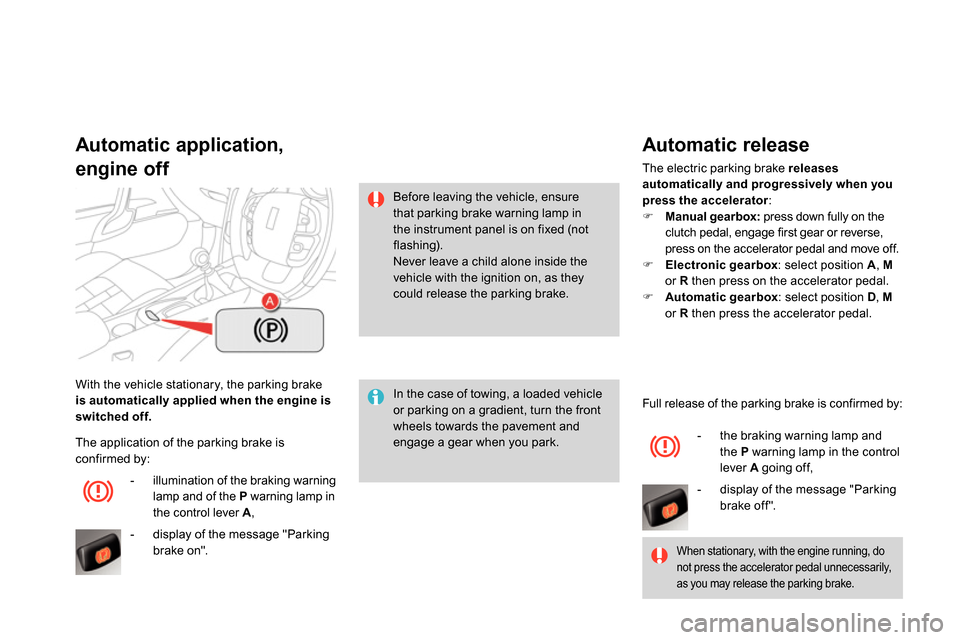
With the vehicle stationary, the parking brake
is automatically applied when the engine is
switched off.
Automatic application,
engine off
In the case of towing, a loaded vehicle
or parking on a gradient, turn the front
wheels towards the pavement and
engage a gear when you park.
Before leaving the vehicle, ensure
that parking brake warning lamp in
the instrument panel is on fixed (not
flashing).
Never leave a child alone inside the
vehicle with the ignition on, as they
could release the parking brake.
- illumination of the braking warning
lamp and of the P
warning lamp in
the control lever A
,
- display of the message "Parking
brake on". The application of the parking brake is
confirmed by:
Automatic release
The electric parking brake releases
automatically and progressively
when you
press the accelerator:
Manual gearbox:
press down fully on the
clutch pedal, engage first gear or reverse,
press on the accelerator pedal and move off.
Electronic gearbox
: select position A
, M
or R
then press on the accelerator pedal.
Automatic gearbox
: select position D
, M
or R
then press the accelerator pedal.
When stationary, with the engine running, do
not press the accelerator pedal unnecessarily,
as you may release the parking brake.
Full release of the parking brake is confirmed by:
- the braking warning lamp and
the P
warning lamp in the control
lever A
going off,
- display of the message "Parking
brake off ".
Page 200 of 400
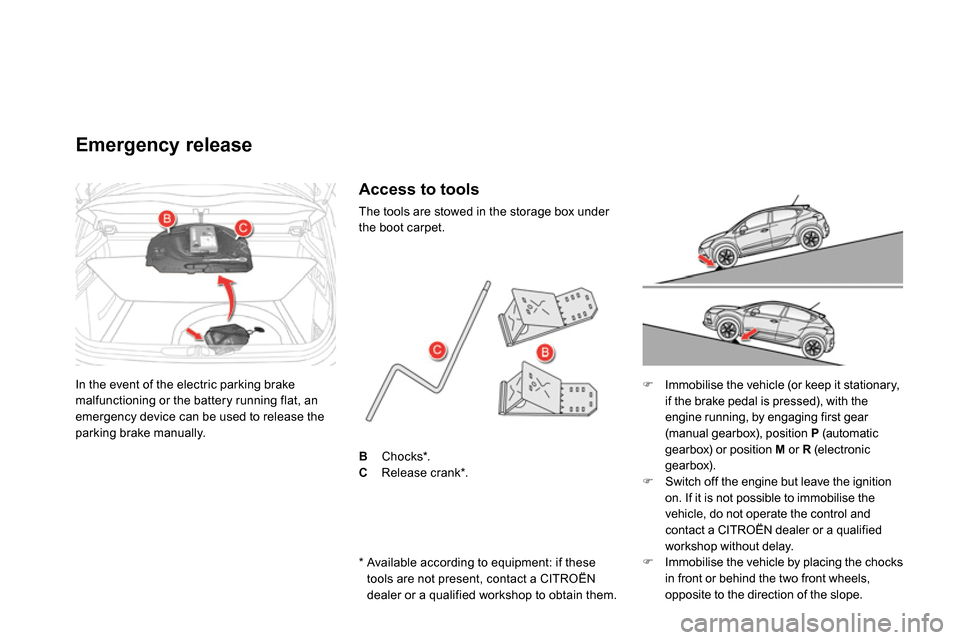
In the event of the electric parking brake
malfunctioning or the battery running flat, an
emergency device can be used to release the
parking brake manually.
Emergency release
Immobilise the vehicle (or keep it stationary,
if the brake pedal is pressed), with the
engine running, by engaging first gear
(manual gearbox), position P
(automatic
gearbox) or position M
or R
(elec tronic
gearbox).
Switch off the engine but leave the ignition
on. If it is not possible to immobilise the
vehicle, do not operate the control and
contact a CITROËN dealer or a qualified
workshop without delay.
Immobilise the vehicle by placing the chocks
in front or behind the two front wheels,
opposite to the direction of the slope.
Access to tools
The tools are stowed in the storage box under
the boot carpet.
B
Chocks*.
C
Release crank*.
* Available according to equipment: if these
tools are not present, contact a CITROËN
dealer or a qualified workshop to obtain them.
Page 201 of 400
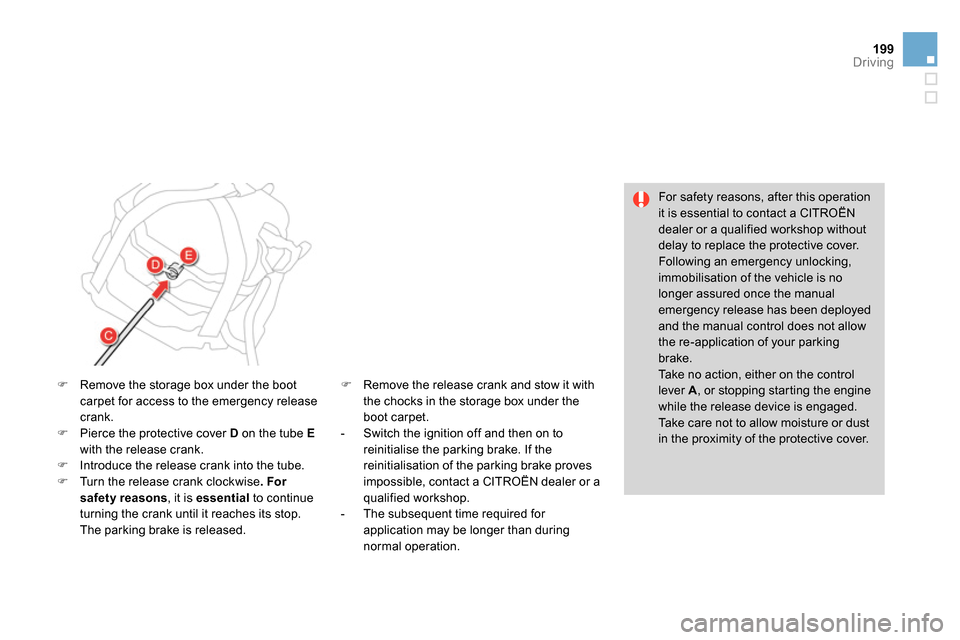
199Driving
For safety reasons, after this operation
it is essential to contact a CITROËN
dealer or a qualified workshop without
delay to replace the protective cover.
Following an emergency unlocking,
immobilisation of the vehicle is no
longer assured once the manual
emergency release has been deployed
and the manual control does not allow
the re-application of your parking
brake.
Take no action, either on the control
lever A
, or stopping starting the engine
while the release device is engaged.
Take care not to allow moisture or dust
in the proximity of the protective cover.
Remove the storage box under the boot
carpet for access to the emergency release
crank.
Pierce the protective cover D
on the tube E
with the release crank.
Introduce the release crank into the tube.
Turn the release crank clockwise .
For
safety reasons
, it is essential
to continue
turning the crank until it reaches its stop.
The parking brake is released.
Remove the release crank and stow it with
the chocks in the storage box under the
boot carpet.
- Switch the ignition off and then on to
reinitialise the parking brake. If the
reinitialisation of the parking brake proves
impossible, contact a CITROËN dealer or a
qualified workshop.
- The subsequent time required for
application may be longer than during
normal operation.
Page 212 of 400
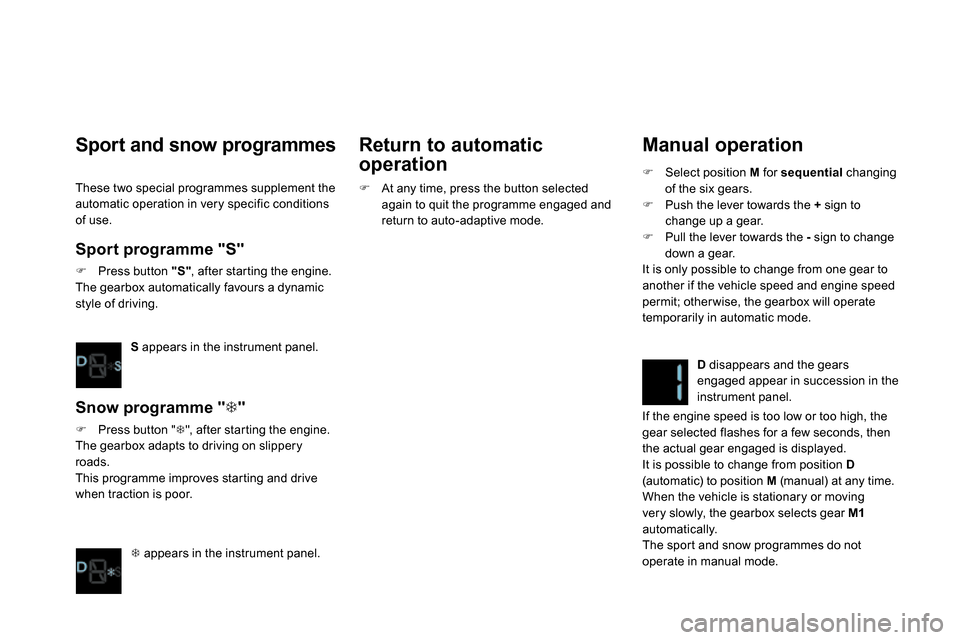
Manual operation
Select position M
for sequential
changing
of the six gears.
Push the lever towards the +
sign to
change up a gear.
Pull the lever towards the -
sign to change
down a gear.
It is only possible to change from one gear to
another if the vehicle speed and engine speed
permit; other wise, the gearbox will operate
temporarily in automatic mode.
D
disappears and the gears
engaged appear in succession in the
instrument panel.
If the engine speed is too low or too high, the
gear selected flashes for a few seconds, then
the actual gear engaged is displayed.
It is possible to change from position D
(automatic) to position M
(manual) at any time.
When the vehicle is stationary or moving
very slowly, the gearbox selects gear M1
automatically.
The sport and snow programmes do not
operate in manual mode.
Sport and snow programmes
Sport programme "S"
Press button "S"
, after starting the engine.
The gearbox automatically favours a dynamic
style of driving.
S
appears in the instrument panel.
Snow programme "
"
Press button "
", after starting the engine.
The gearbox adapts to driving on slippery
roads.
This programme improves starting and drive
when traction is poor.
appears in the instrument panel.
Return to automatic
operation
At any time, press the button selected
again to quit the programme engaged and
return to auto-adaptive mode.
These two special programmes supplement the
automatic operation in very specific conditions
of use.
Page 223 of 400
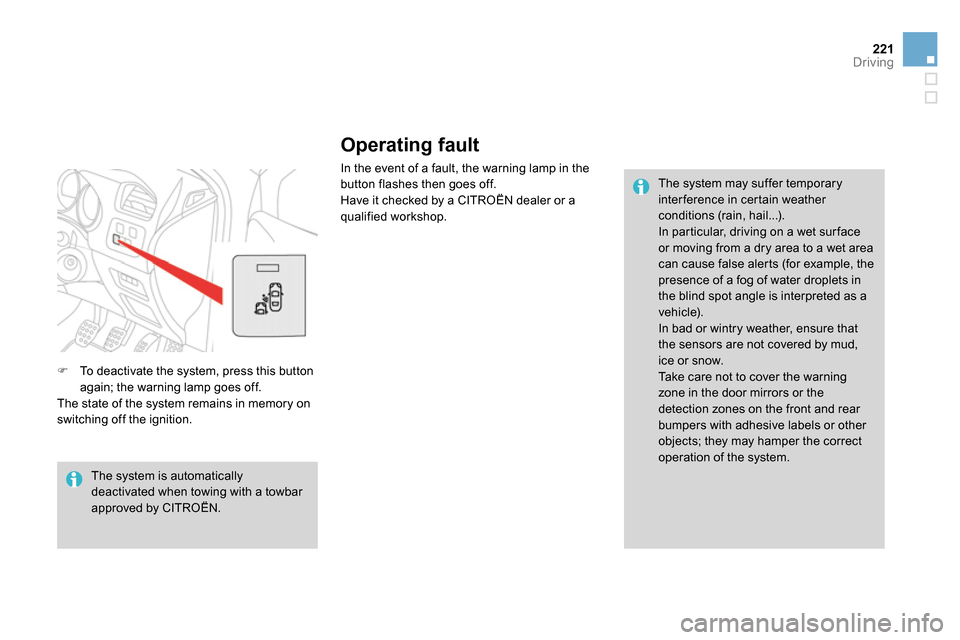
221Driving
Operating fault
In the event of a fault, the warning lamp in the
button flashes then goes off.
Have it checked by a CITROËN dealer or a
qualified workshop.
The system may suffer temporary
inter ference in certain weather
conditions (rain, hail...).
In particular, driving on a wet sur face
or moving from a dry area to a wet area
can cause false alerts (for example, the
presence of a fog of water droplets in
the blind spot angle is interpreted as a
vehicle).
In bad or wintry weather, ensure that
the sensors are not covered by mud,
ice or snow.
Take care not to cover the warning
zone in the door mirrors or the
detection zones on the front and rear
bumpers with adhesive labels or other
objects; they may hamper the correct
operation of the system.
To deactivate the system, press this button
again; the warning lamp goes off.
The state of the system remains in memory on
switching off the ignition.
The system is automatically
deactivated when towing with a towbar
approved by CITROËN.
Page 228 of 400
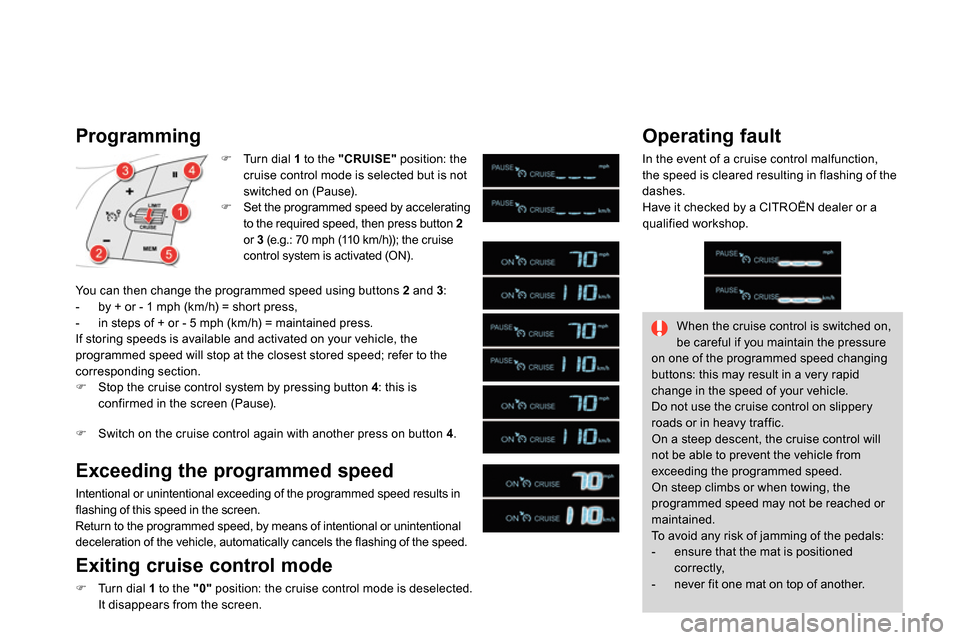
Programming
Turn dial 1
to the "CRUISE"
position: the
cruise control mode is selected but is not
switched on (Pause).
Set the programmed speed by accelerating
to the required speed, then press button 2
or 3
(e.g.: 70 mph (110 km/h)); the cruise
control system is activated (ON).
You can then change the programmed speed using buttons 2
and 3
:
- by + or - 1 mph (km/h) = short press,
- in steps of + or - 5 mph (km/h) = maintained press.
If storing speeds is available and activated on your vehicle, the
programmed speed will stop at the closest stored speed; refer to the
corresponding section.
Stop the cruise control system by pressing button 4
: this is
confirmed in the screen (Pause).
Switch on the cruise control again with another press on button 4
.
Exceeding the programmed speed
Intentional or unintentional exceeding of the programmed speed results in
flashing of this speed in the screen.
Return to the programmed speed, by means of intentional or unintentional
deceleration of the vehicle, automatically cancels the flashing of the speed.
Exiting cruise control mode
Turn dial 1
to the "0"
position: the cruise control mode is deselected.
It disappears from the screen.
Operating fault
In the event of a cruise control malfunction,
the speed is cleared resulting in flashing of the
dashes.
Have it checked by a CITROËN dealer or a
qualified workshop.
When the cruise control is switched on,
be careful if you maintain the pressure
on one of the programmed speed changing
buttons: this may result in a very rapid
change in the speed of your vehicle.
Do not use the cruise control on slippery
roads or in heavy traffic.
On a steep descent, the cruise control will
not be able to prevent the vehicle from
exceeding the programmed speed.
On steep climbs or when towing, the
programmed speed may not be reached or
maintained.
To avoid any risk of jamming of the pedals:
- ensure that the mat is positioned
correctly,
- never fit one mat on top of another.
Page 232 of 400
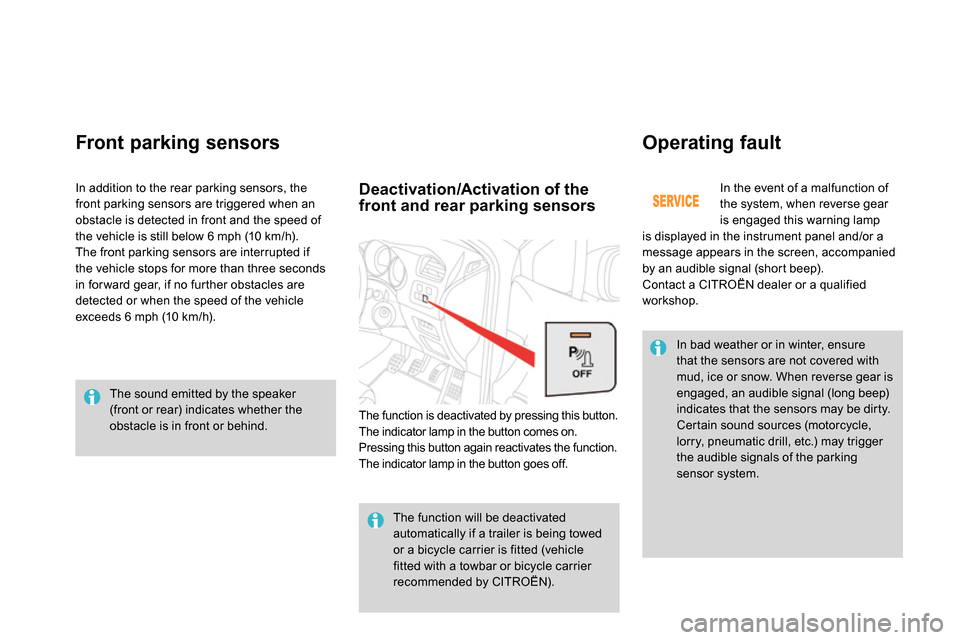
Front parking sensors
Operating fault
In the event of a malfunction of
the system, when reverse gear
is engaged this warning lamp
is displayed in the instrument panel and/or a
message appears in the screen, accompanied
by an audible signal (short beep).
Contact a CITROËN dealer or a qualified
workshop. In addition to the rear parking sensors, the
front parking sensors are triggered when an
obstacle is detected in front and the speed of
the vehicle is still below 6 mph (10 km/h).
The front parking sensors are interrupted if
the vehicle stops for more than three seconds
in for ward gear, if no further obstacles are
detected or when the speed of the vehicle
exceeds 6 mph (10 km/h).
The function will be deactivated
automatically if a trailer is being towed
or a bicycle carrier is fitted (vehicle
fitted with a towbar or bicycle carrier
recommended by CITROËN).
In bad weather or in winter, ensure
that the sensors are not covered with
mud, ice or snow. When reverse gear is
engaged, an audible signal (long beep)
indicates that the sensors may be dirty.
Certain sound sources (motorcycle,
lorry, pneumatic drill, etc.) may trigger
the audible signals of the parking
sensor system.
Deactivation/Activation of the
front and rear parking sensors
The function is deactivated by pressing this button.
The indicator lamp in the button comes on.
Pressing this button again reactivates the function.
The indicator lamp in the button goes off.
The sound emitted by the speaker
(front or rear) indicates whether the
obstacle is in front or behind.
Page 236 of 400

TOTAL & CITROËN
Partners in performance and
protecting the environment
Innovation in the search for
performance
For over 40 year, the TOTAL Research and
Development departments have developed for
CITROËN, lubricants to match the latest technical
innovations on CITROËN vehicles, both for
competition and for everyday motoring.
For you, this is an assurance that you will obtain of
the best per formance for your engine.
Optimum protection for
your engine
By having your CITROËN vehicle
serviced with TOTAL lubricants, you
are contributing towards improving the
life and per formances of your engine,
while also protecting the environment.
prefers
Page 246 of 400
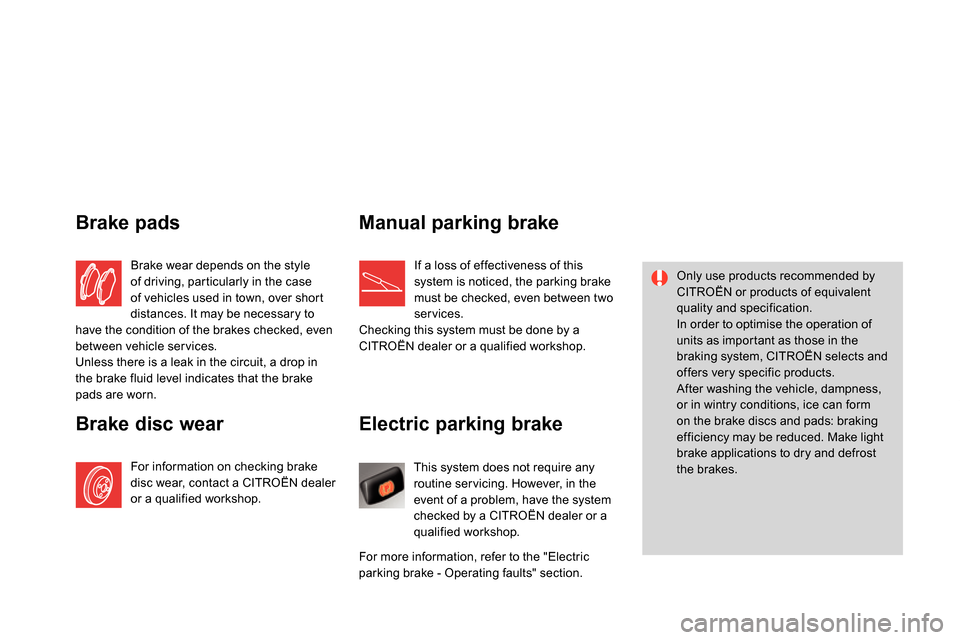
Electric parking brake
This system does not require any
routine ser vicing. However, in the
event of a problem, have the system
checked by a CITROËN dealer or a
qualified workshop.
Only use products recommended by
CITROËN or products of equivalent
quality and specification.
In order to optimise the operation of
units as important as those in the
braking system, CITROËN selects and
offers very specific products.
After washing the vehicle, dampness,
or in wintry conditions, ice can form
on the brake discs and pads: braking
efficiency may be reduced. Make light
brake applications to dry and defrost
the brakes.
Brake disc wear
For information on checking brake
disc wear, contact a CITROËN dealer
or a qualified workshop.
Manual parking brake
If a loss of effectiveness of this
system is noticed, the parking brake
must be checked, even between two
services.
Checking this system must be done by a
CITROËN dealer or a qualified workshop.
Brake pads
Brake wear depends on the style
of driving, particularly in the case
of vehicles used in town, over short
distances. It may be necessary to
have the condition of the brakes checked, even
between vehicle ser vices.
Unless there is a leak in the circuit, a drop in
the brake fluid level indicates that the brake
pads are worn.
For more information, refer to the "Electric
parking brake - Operating faults" section.